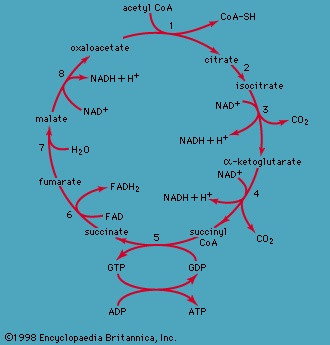tricarboxylic acid cycle
biochemistry
(TCA cycle), also called Krebs cycle and citric acid cycle,
the second stage of cellular respiration, the three-stage process by which living cells break down organic fuel molecules in the presence of oxygen to harvest the energy they need to grow and divide. This metabolic process occurs in most plants, animals, fungi, and many bacteria. In all organisms except bacteria the TCA cycle is carried out in the matrix of intracellular structures called mitochondria.
The TCA cycle plays a central role in the breakdown, or catabolism, of organic fuel molecules—i.e., glucose and some other sugars, fatty acids, and some amino acids. Before these rather large molecules can enter the TCA cycle they must be degraded into a two-carbon compound called acetyl coenzyme A (acetyl CoA). Once fed into the TCA cycle, acetyl CoA is converted into carbon dioxide and energy.
 The TCA cycle consists of eight steps catalyzed by eight different enzymes (see Figure-->
The TCA cycle consists of eight steps catalyzed by eight different enzymes (see Figure--> ). The cycle is initiated (1) when acetyl CoA reacts with the compound oxaloacetate to form citrate and to release coenzyme A (CoA-SH). Then, in a succession of reactions, (2) citrate is rearranged to form isocitrate; (3) isocitrate loses a molecule of carbon dioxide and then undergoes oxidation to form alpha-ketoglutarate; (4) alpha-ketoglutarate loses a molecule of carbon dioxide and is oxidized to form succinyl CoA; (5) succinyl CoA is enzymatically converted to succinate; (6) succinate is oxidized to fumarate; (7) fumarate is hydrated to produce malate; and, to end the cycle, (8) malate is oxidized to oxaloacetate. Each complete turn of the cycle results in the regeneration of oxaloacetate and the formation of two molecules of carbon dioxide.
). The cycle is initiated (1) when acetyl CoA reacts with the compound oxaloacetate to form citrate and to release coenzyme A (CoA-SH). Then, in a succession of reactions, (2) citrate is rearranged to form isocitrate; (3) isocitrate loses a molecule of carbon dioxide and then undergoes oxidation to form alpha-ketoglutarate; (4) alpha-ketoglutarate loses a molecule of carbon dioxide and is oxidized to form succinyl CoA; (5) succinyl CoA is enzymatically converted to succinate; (6) succinate is oxidized to fumarate; (7) fumarate is hydrated to produce malate; and, to end the cycle, (8) malate is oxidized to oxaloacetate. Each complete turn of the cycle results in the regeneration of oxaloacetate and the formation of two molecules of carbon dioxide.Energy is produced in a number of steps in this cycle of reactions. In step 5, one molecule of adenosine triphosphate (ATP), the molecule that powers most cellular functions, is produced. Most of the energy obtained from the TCA cycle, however, is captured by the compounds nicotinamide adenine dinucleotide (NAD+) and flavin adenine dinucleotide (FAD) and converted later to ATP. Energy transfers occur through the relay of electrons from one substance to another, a process carried out through the chemical reactions known as oxidation and reduction, or redox reactions. (Oxidation involves the loss of electrons from a substance and reduction the addition of electrons.) For each turn of the TCA cycle, three molecules of NAD+ are reduced to NADH and one molecule of FAD is reduced to FADH2. These molecules then transfer their energy to the electron transport chain, a pathway that is part of the third stage of cellular respiration. The electron transport chain in turn releases energy so that it can be converted to ATP through the process of oxidative phosphorylation.
The German-born British biochemist Sir Hans Adolf Krebs (Krebs, Sir Hans Adolf) proposed this cycle, which he called the citric acid cycle, in 1937. For his work he received the 1953 Nobel Prize in Physiology or Medicine. Although Krebs elucidated most of the reactions in this pathway, there were some gaps in his design. The discovery of coenzyme A in 1945 by Fritz Lipmann and Nathan Kaplan allowed researchers to work out the cycle of reactions as it is known today.
- Reggie Jackson
- Reggio di Calabria
- Reggio nell'Emilia
- regiment
- Regina
- Reginald Aldworth Daly
- Reginald Aubrey Fessenden
- Reginald Crundall Punnett
- Reginald De Koven
- Reginald Edward Harry Dyer
- Reginald Innes Pocock
- Reginald Marsh
- Reginald McKenna
- Reginald of Châtillon
- Reginald Pole
- Regina M. Anderson
- Regino Von Prüm
- Regiomontanus
- region
- regional development program
- regium donum
- Regla
- Regnard, Jean-François
- Regnault de Saint Jean d'Angély, Michel-Louis-Étienne, Comte
- Regnault, Henri-Victor